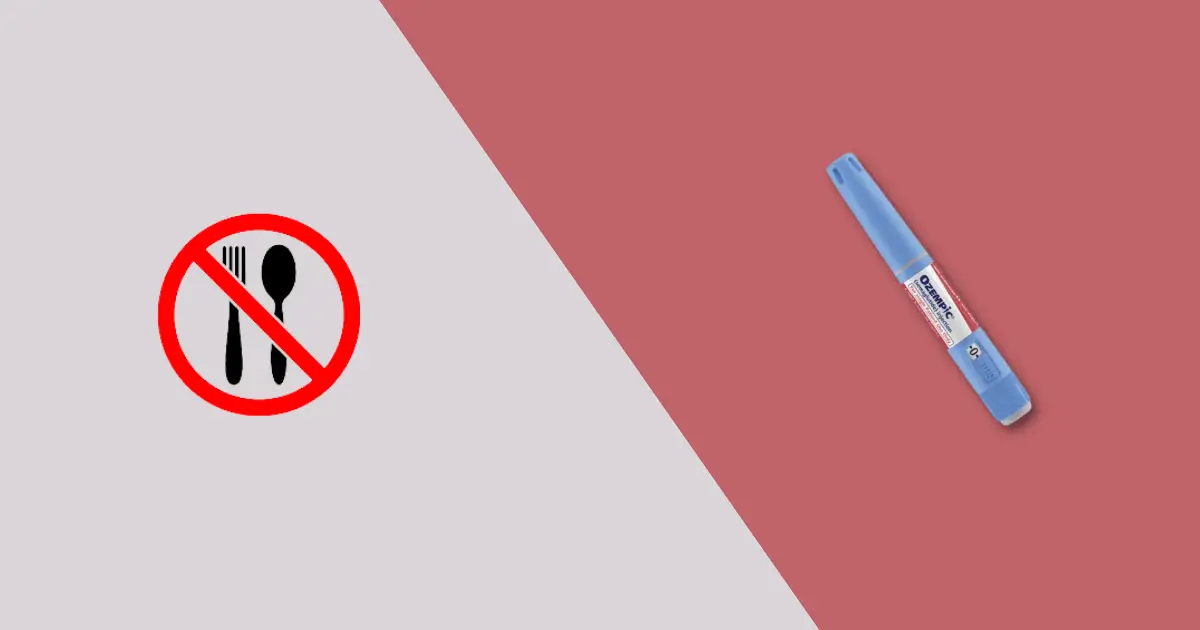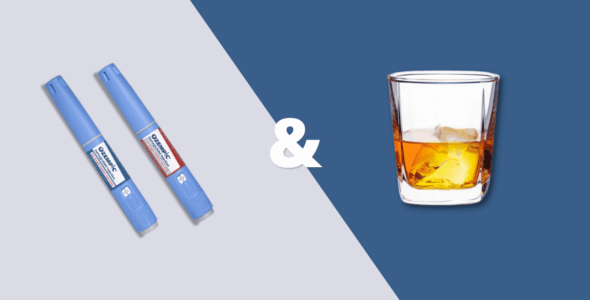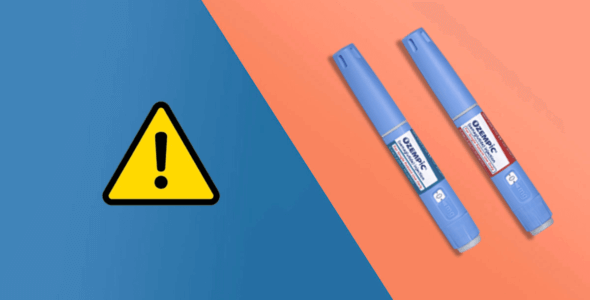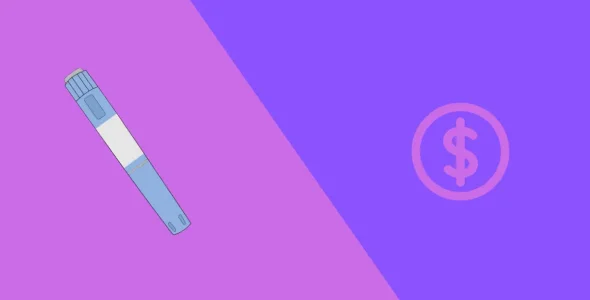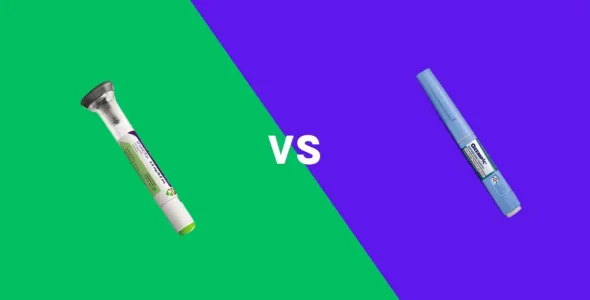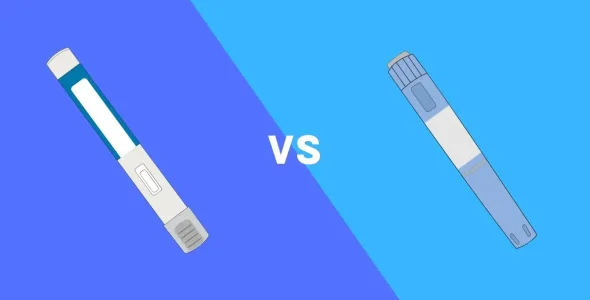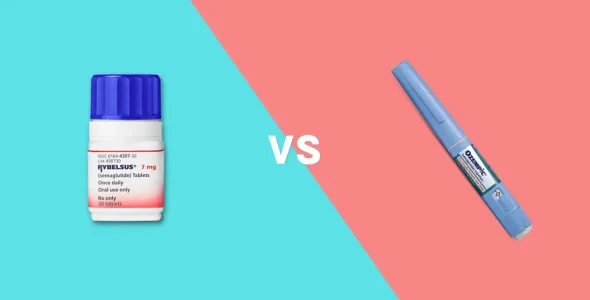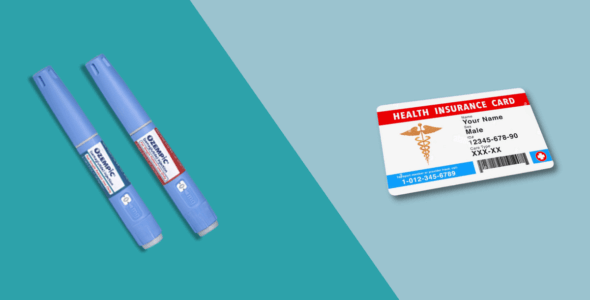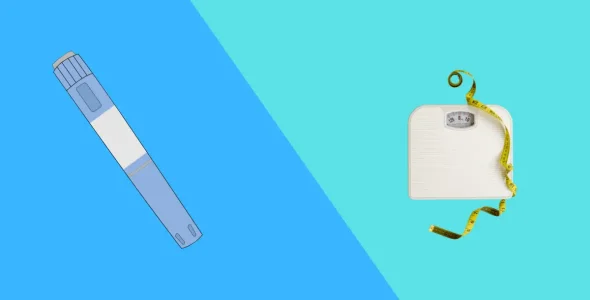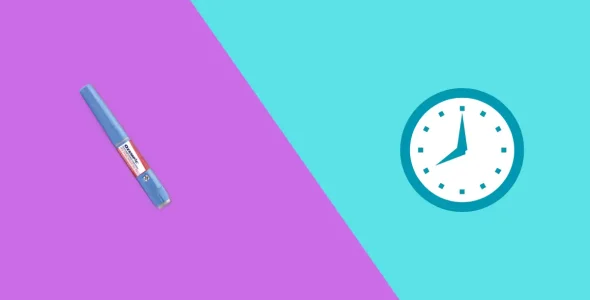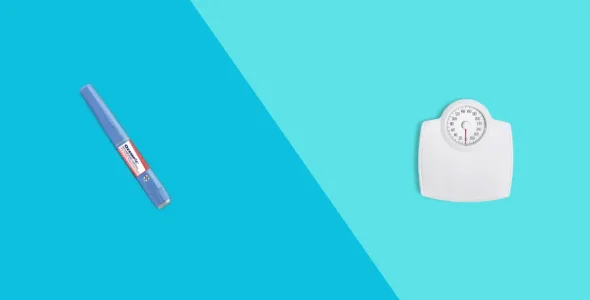Ozempic foods to avoid: Diet guide to prevent side effects and maximize results
Avoid high-fat, fried, sugary, and large-portioned foods on Ozempic to prevent side effects like nausea and diarrhea while maximizing weight loss and blood sugar control.
Key highlights
- Ozempic changes how your body digests food, controls blood sugar, and feels hunger. These changes make certain foods more difficult to tolerate and others more helpful in managing side effects.
- High-fat, sugary, processed, and large meals can worsen nausea, bloating, and other digestive symptoms. Lean proteins, fiber, non-starchy vegetables, and hydrating fluids support Ozempic’s benefits and are generally easier on the stomach.
- Timing and portion control matter just as much as food type. Understanding when to eat, how much to eat, and how to build balanced meals can improve how you feel while taking Ozempic.
Ozempic (semaglutide) is a once-weekly, FDA-approved medication used to manage type 2 diabetes in adults, when paired with lifestyle changes such as a low-calorie diet and exercise. While Ozempic is primarily approved for improving blood sugar and reducing the risk of cardiovascular and renal complications, many healthcare providers also prescribe it off-label for weight loss. If you are overweight or have obesity, your doctor may recommend Ozempic to support your long-term weight management goals, especially if you have related health conditions like high blood pressure or high cholesterol.
Although Ozempic can be highly effective, what you eat plays an important role in how well the medication works for you. Certain foods may exacerbate common side effects, such as nausea, bloating, and indigestion. They can also slow your progress or interfere with your blood sugar levels. By making mindful dietary choices, you can reduce discomfort and help Ozempic work better for your body.
In this guide, you’ll learn which foods to approach with caution while taking Ozempic, why they may cause issues, and which healthier alternatives you can try instead.
Understanding how Ozempic affects your digestion and appetite
Ozempic is administered under your skin, typically in the abdomen, thigh, or upper arm. This method is used because semaglutide is a peptide-based drug that would break down if taken by mouth in its original form. The drug belongs to a class of medications called GLP-1 receptor agonists. It works by mimicking the action of the body’s natural GLP-1 hormone. This hormone regulates blood sugar, digestion, and appetite control. By mimicking the action of the GLP-1 hormone, the medication promotes blood sugar control and aids weight loss. It’s also approved for chronic weight management under the brand name Wegovy.
Ozempic slows down the rate at which food exits your stomach. This effect helps you feel full longer and eat less. However, meals that are high in fat or oil can take even more time to digest and may sit heavily in your stomach. Foods like fried items, creamy sauces, or fast food burgers can cause bloating, nausea, or heartburn. Eating smaller, low-fat meals can help reduce these side effects and improve your comfort.
Appetite suppression
The medication signals your brain to reduce hunger and increase feelings of fullness. If you continue to eat the same large portions you were used to before starting Ozempic, you might feel overly full or nauseous. Eating more than your body needs while your digestion is already slower can cause discomfort. Try eating slowly and stop when you begin to feel satisfied.
Feeling full longer
Ozempic helps reduce how often you feel hungry and lowers the urge to eat between meals. However, this same effect means that calorie-dense or rich foods can become harder to tolerate. Calorie-dense meals, such as creamy pasta, thick casseroles, and sugary desserts, stay in the stomach for even longer and can cause nausea, bloating, or a heavy feeling. These foods may also delay your next meal since your body is still working to digest the previous one. Choosing lighter meals with a balance of protein, fiber, and healthy fats can support steady digestion.
Better blood sugar control
Ozempic helps your body release more insulin when your blood sugar is high. The medication also lowers the amount of another hormone called glucagon, which is released from alpha cells of the pancreas, and usually raises blood sugar levels. As well, Ozempic slows how fast your body digests food, which helps prevent sudden spikes in blood sugar after meals.
Even with these benefits, eating high-sugar foods can still cause sudden increases in blood glucose levels. Items such as candies, sweetened beverages, pastries, and sugary cereals are quickly absorbed and can interfere with blood sugar stability. These foods may also trigger nausea, especially when your stomach is already more sensitive due to slower digestion. To help maintain your blood sugar within a healthy range, choose foods that have a low glycemic index and release sugar more gradually.
5 worst food categories to avoid while taking Ozempic
Some foods can make Ozempic side effects worse or reduce how well the medication works. Being selective about these types of foods can help you achieve your weight loss and health goals.
Fried and high-fat foods
Gastric emptying can become more delayed when paired with greasy foods, fried foods, or fatty meals. They can increase the gastrointestinal side effects of Ozempic. Fat-dense foods to avoid include:
- Fried like French fries, fried chicken, and onion rings
- Fatty meats like bacon, sausages, and marbled cuts of beef
- Processed snacks such as potato chips and greasy crackers
- Pizza with extra cheese or processed meats
- Heavy cream-based sauces, pastas, and gravies
- Pastries, donuts, and buttery baked goods
- Full-fat dairy like whole milk, cream, and full-fat cheeses
Sugary foods and drinks
Added sugars do more than just raise your blood sugar. They may also affect how your body responds to GLP-1, the same hormone that Ozempic mimics. In a study with 72 adults with obesity, people who consumed the most added sugar showed the smallest increase in their natural GLP-1 levels after eating glucose. This means that eating too much added sugar may weaken the hormone response that helps regulate appetite and blood sugar levels.
Sugary foods also contain a lot of calories without providing nutrients or fiber. If you are using Ozempic for weight loss, added sugar can slow down your progress. A high intake of sugar can also worsen nausea or diarrhea, especially if your digestion is already slowed. Common sugary foods and drinks to limit:
- Soda
- Sweetened soft drinks
- Fruit juices with added sugar
- Candy
- Chocolate bars
- Sweetened breakfast cereals
- Baked goods like cakes, cookies, and muffins
- Ice cream and frozen desserts
- Sweetened yogurt with fruit or syrup
Processed and packaged foods
Processed foods are full of sugar, salt, and unhealthy fats. Many also contain additives like emulsifiers that may cause gastrointestinal symptoms even in healthy populations.
Such foods often cause bloating, gas, and discomfort, especially when digestion is already slowed. They also tend to lack the fiber and nutrients your body needs to stay full and healthy, which can make you more likely to overeat or crave unhealthy snacks. They may also have artificial sweeteners that can increase your blood sugar levels if you have diabetes. Processed foods to watch out for include:
- Frozen meals labeled as “low calorie” or “diet” but high in sodium
- Packaged snacks like chips, pretzels, and flavored crackers
- Processed meats like frozen hot dogs, deli slices, and sausages
- Protein bars containing artificial sweeteners or sugar alcohols
- Boxed macaroni and cheese and instant noodles
- Fast food items with preservatives or artificial ingredients
Alcohol
Alcohol can inflame the lining of your gastrointestinal tract, which may make Ozempic’s side effects more intense. While alcohol may cause a short-term rise in blood sugar, it can also result in a sudden drop later on. For people with diabetes, this may increase the risk of hypoglycemia, especially if alcohol masks early warning signs like dizziness or shakiness.
In addition, both alcohol and Ozempic may contribute to dehydration. If you are already experiencing vomiting or diarrhea, drinking alcohol may worsen fluid loss and make you feel even more unwell. Types of alcohol to limit or avoid at all costs include:
- Beer, including light and craft varieties
- Wine, especially sweet wines or dessert wines
- Liquors such as vodka, rum, whiskey, and gin
- Sugary mixed drinks like margaritas or piña coladas
- Hard seltzers with added sweeteners
Carbonated beverages
Carbonated drinks release gas into your stomach, which can cause bloating, belching, and discomfort. Since Ozempic already slows digestion, adding gas from fizzy drinks may make you feel overly full or nauseous.
Even sugar-free sodas and sparkling waters can cause issues. The gas builds up and may not pass through your system easily. This can increase pressure in your stomach and make side effects more noticeable. Carbonated drinks to limit while you’re taking Ozempic include:
- Soda, both regular and diet
- Sparkling water with or without artificial flavors
- Beer and hard seltzers
- Carbonated energy drinks
- Fizzy juice or flavored sparkling drinks
Large meals
When you eat more food than your stomach’s capacity, it may sit longer in your digestive tract when you are taking Ozempic. This can lead to fullness that lasts for hours or delayed hunger for the next meal. Oversized portions of dense foods like creamy pasta dishes or buffet-style plates are more likely to cause discomfort.
Ultra-processed carbohydrates
Foods made with refined carbohydrates break down quickly in the digestive system. They cause a rapid increase in blood sugar levels, which can work against the effects of Ozempic, especially for people using it to manage type 2 diabetes.
These foods are usually low in fiber and nutrients. They do not keep you full for long and can lead to more cravings later in the day. Examples of ultra-processed carbs include:
- White bread
- White rice
- Regular pasta
- Saltine crackers
- Instant noodles
- Pastries made with enriched flour
Starchy vegetables
Vegetables are healthy, but some are high in starch. These starchy vegetables turn into sugar quickly and can raise blood sugar levels. If you are taking Ozempic, this may make the medication less effective. Examples of starchy vegetables to limit include:
- White potatoes
- Corn
- Green peas
- Mashed parsnips
- Rutabaga.
- Roasted potatoes with butter
- Corn on the cob
- Creamed corn
Foods that may worsen Ozempic side effects
Ozempic can make your digestive system more sensitive. Side effects like nausea, diarrhea, or constipation are more common during the first few weeks of treatment or when your dose increases. If certain foods have caused you discomfort in the past, it is best to limit or avoid them while your body adjusts to Ozempic.
Foods to avoid if you feel nauseous on Ozempic
Nausea and heartburn are two of the most common side effects of Ozempic. Eating spicy, acidic, and fatty foods can make them worse. Moreover, spicy foods upset the stomach and can cause stomach pain. Try to avoid:
- Spicy dishes such as hot wings, chilli, or curry
- Hot sauces, pepper-based condiments, and wasabi
- Acidic foods like oranges, lemons, grapefruits, and tomatoes
- Vinegar-based salad dressings or pickled foods
Foods to avoid if you experience diarrhea on Ozempic
Some people may have diarrhea while adjusting to Ozempic. This symptom can be worsened by foods that are difficult to digest or that draw water into the digestive tract. In this case, avoid:
- Dairy products such as milk, yogurt, and cheese, especially if you are lactose intolerant
- Sugar-free products may contain artificial sweeteners like sorbitol or xylitol (often found in gum, mints, or protein bars)
- High-fat or fried foods that are harder to digest
Foods to avoid if you are constipated while taking Ozempic
While diarrhea is common while taking Ozempic, some people may experience constipation instead. This can happen when digestion slows too much or when fiber is suddenly added in large amounts. If Ozempic makes you constipated, try to avoid:
- Processed carbohydrates with refined grains, such as white bread, white pasta, and white rice
- Red meats like beef, lamb, or sausage
- Foods low in fiber and fluids
Foods to limit on Ozempic if you have gluten sensitivity
If you have gluten intolerance, having foods that contain gluten may lead to bloating, stomach cramps, or diarrhea. This can worsen if you consume the following foods while on Ozempic:
- Wheat-based products like pasta, white bread, and baked goods
- Crackers, cakes, and other packaged snacks that contain wheat flour
Be cautious with high-fiber foods while starting Ozempic
High-fiber foods are good for your gut, but taking too much fiber too quickly can result in bloating, gas, or stomach discomfort. If you are new to Ozempic, your digestive system may already be sensitive, and large amounts of fiber may make it worse.
High-fiber foods to introduce slowly include:
- Beans and lentils
- Bran cereals and whole wheat breads
- Raw vegetables like cabbage or broccoli
Foods to eat while taking Ozempic
Choosing the right specific foods can help reduce common side effects of Ozempic, like nausea, constipation, and fluctuations in blood sugar levels. The following options are better tolerated by most people and support the overall goals of Ozempic treatment.
Lean proteins
While high-fat meats like bacon or sausage may increase nausea or slow digestion, lean proteins offer the same benefits without the discomfort. They support muscle strength, help you feel full, and are easier for your body to process while taking Ozempic. Examples of lean proteins include:
- Skinless poultry
- Chicken breast
- Turkey breast
- Baked or grilled fish
- Lean cuts of beef
- Tofu
- Legumes
- Plain Greek yogurt
Fiber-rich foods
Processed carbs like white bread and crackers are low in fiber and can lead to increased blood sugar levels. In contrast, fiber-rich foods support digestion, prevent constipation, and help stabilize blood sugar. Introduce them slowly to avoid bloating, especially if your body is adjusting to Ozempic. Examples of fiber-rich foods include:
- Oatmeal
- Fresh berries
- Broccoli
- Granola and snack bars
- Popcorn
- Trailmix
Non-starchy vegetables
Non-starchy vegetables have fewer carbohydrates than starchy vegetables. They are less likely to increase your blood sugar and are easier to digest. They also provide important vitamins, which makes them a healthy everyday choice. Non-starchy vegetables include:
- Broccoli
- Spinach
- Leafy greens like kale and romaine
- Lettuce
- Cucumbers
- Tomatoes
- Radishes
- Carrots
- Bell peppers
- Zucchini
Whole grains
Refined grains such as white rice or bread digest quickly and may cause blood sugar spikes. Whole grains break down more slowly, provide more fiber, and help keep you full longer.
Start with small portions to prevent feeling overly full, since Ozempic slows down digestion. They are better tolerated by your body and can work well with Ozempic’s effects on appetite and blood sugar. These include:
- Whole wheat
- Oats
- Brown rice
- Quinoa
- Barley
- Rye
Healthy fats
While greasy or fried foods can delay stomach emptying and increase nausea, healthy fats offer benefits without the same risks. These fats help absorb vitamins, support brain and heart health, and contribute to a feeling of satisfaction after meals.
Remember to stick to small portions since fats are dense in calories, even when they are healthy. You can try the following healthy fats:
- Avocado
- Nuts
- Seeds
- Olive oil
Low-glycemic fruits
Desserts, pastries, and sugary snacks can raise blood sugar quickly and may upset your stomach on Ozempic. Low-glycemic fruits offer natural sweetness, fiber, and essential nutrients without causing spikes in your blood sugar. Whole fruits also have a minimal risk of obesity.
You can pair fruits with protein or a small amount of fat for more stable blood sugar levels. Fruits with low-glycemic index include:
- Fresh berries
- Apples
- Citrus fruits such as oranges or grapefruit
- Pears (small servings)
Hydrating fluids
Unlike alcohol or sugary sodas, which may worsen nausea or dehydration, hydrating fluids help your digestive system work more smoothly. They also prevent constipation and support your body during side effects like vomiting or diarrhea.
You should drink fluids regularly throughout the day to stay well hydrated, especially when adjusting to a new dose of Ozempic. Examples of hydrating fluids include:
- Water
- Herbal tea
- Clear broths
- Electrolyte drinks (without added sugar)
Timing matters: When to eat on Ozempic
Ozempic can change how you experience hunger and fullness. Timing your meals can help you avoid common issues like overeating, nausea, or feeling overly full.
It is also important to eat before you become extremely hungry. When you wait too long to eat, you are more likely to eat quickly and excessively, which may lead to discomfort. On the other hand, because Ozempic slows digestion, it also delays the feeling of fullness.
This means you may need to stop eating based on portion size or a mild feeling of satisfaction rather than waiting until you feel full. Here are some timing tips to support your Ozempic routine:
- Eat small, balanced meals throughout the day.
- Do not skip meals, especially at the beginning of your treatment.
- Eat slowly and stop when you feel about 70 to 80% full.
Sample eating Schedule while taking Ozempic
Here is a sample meal plan to help you space out your meals in a way that supports digestion and avoids overeating. All options are easy to digest and contain protein, fiber, or healthy fats.
| Time | Meal | Foods to eat | Why it helps |
|---|---|---|---|
| 08:00 | Light breakfast | Protein shake with Greek yogurt and berries Boiled eggs with whole-grain toast Plain oatmeal with chia seeds and a banana slice | Easy to digest and helps start your day without overwhelming your stomach |
| 12:00 | Lunch | Grilled chicken or tofu salad with olive oil dressing Turkey wrap with lettuce and whole grain tortilla Quinoa bowl with roasted vegetables and chickpeas | A balanced lunch with protein and fiber keeps you full without heaviness. |
| 15:00 | Light snack | A handful of almonds or walnuts Apple slices with peanut butter Small cup of plain Greek yogurt with berries | Healthy fat and fiber help manage hunger between meals |
| 18:00 | Dinner | Baked lean meats with brown rice and steamed vegetables Stir-fried tofu with mixed vegetables Chicken breast with sweet potato and spinach | A nutrient-rich, light dinner can support digestion overnight |
Tips for managing a healthy diet while on Ozempic
When using Ozempic, what and how you eat can impact how the medication works and how you feel each day. These tips can help support your digestion, improve your comfort, and make your treatment more effective.
Start slow and small
If you are changing your diet or trying new foods, always start with small portions. This gives your digestive system time to adjust and helps reduce the risk of nausea or bloating.
Eat smaller meals more often
Try eating small portions throughout the day instead of large meals. This can reduce stomach discomfort and support smoother digestion, especially as your body adjusts to Ozempic.
Pay attention to your body
Notice how different foods make you feel. Some meals may leave you feeling light and energized, while others may cause discomfort. Use that feedback to guide your food choices.
Drink enough fluids
Keeping your body hydrated is important, especially if you have side effects like constipation, diarrhea, or nausea. Water, herbal teas, and clear broths are good choices that help digestion.
Plan your meals ahead of time.
When you plan your meals, you are more likely to choose healthy, balanced options. Planning can also help you avoid last-minute choices that may be high in fat, sugar, or salt.
Check nutrition labels
Read food packaging carefully to see how much fat, sodium, and added sugar the product contains. This helps you avoid ingredients that may interfere with your goals or cause side effects.
Cook at home more often
Preparing meals at home gives you more control over your ingredients. You can avoid added sugars, excessive salt, and unhealthy fats that are common in takeout and prepackaged meals.
Keep a food journal
Recording everything you eat and how it affects your body can help you identify what foods cause you problems. This is a useful tool for spotting foods that support your progress or those that cause problems.
Avoid making sudden changes
Let your body adjust gradually. Making too many changes at once can overwhelm your digestive system and increase side effects. Slow progress is often more sustainable and easier on your body.
How to manage dietary changes
Changing how you eat can be difficult. It is not just about choosing different foods. It often means changing habits that are tied to your daily routine, emotions, and even your social life. You may feel frustrated at times or left out in certain situations. These feelings are normal and valid.
Be patient with yourself. It takes time to adjust to new habits, especially when using a medication like Ozempic that also changes how your body feels hungry and full. Do not expect perfection. Progress happens step by step.
If you are unsure what to eat or need extra support, consider speaking with a registered dietitian. A professional can help you create a plan that fits your health needs and lifestyle. You may also find it helpful to join a support group, either in person or online, where you can connect with others who are going through a similar journey.
Other tips for avoiding Ozempic side effects
If you are already making healthy food choices and watching your portion sizes, there are still a few more habits that can help you manage Ozempic side effects:
- Chew your food well to help your digestive system work more easily and reduce nausea or bloating.
- Stay upright after meals for one to two hours to avoid acid reflux or heaviness in your stomach.
- Start with smaller portions and wait a few minutes before deciding if you need more food.
- Do not skip meals to prevent intense hunger and decrease the risk of overeating or digestive issues.
- Keep a food and symptom journal to find out which meals support your comfort and which ones may cause issues.
Expert tips to manage cravings on Ozempic
Cravings can still happen while taking Ozempic, even if your appetite has been reduced. Choosing healthier options can help satisfy those hunger pangs without hurting your body:
For sugary cravings
Try frozen grapes or a few small squares of dark chocolate. These provide natural sweetness without added sugar.
For salty cravings
Instead of salty, processed snacks, choose healthier options like roasted chickpeas and air-popped popcorn.
For soda cravings
Switch to sparkling water with lemon or cucumber slices. This adds flavor and fizz without the added sugar.
FAQs about Ozempic foods to avoid
Can I eat fruit while taking Ozempic?
You can eat fruit while on Ozempic. Fruit offers fiber, vitamins, and natural sugars, but some types of fruit can raise your blood sugar quickly. To slow this effect, pair fruit with protein or healthy fat. You can go for options like apple slices with peanut butter or berries with Greek yogurt. Focus on lower-glycemic fruits like berries, apples, and citrus. Keep your portion sizes in check if you are taking Ozempic for type 2 diabetes.
Why does Ozempic make me feel like I hate food?
It is common to feel less interested in food while taking Ozempic. The medication mimics GLP-1, the natural hormone which helps reduce appetite and slows digestion. You may feel full for longer, feel satisfied with smaller meals, or even feel slightly nauseous when thinking about food. These effects are expected and are part of how Ozempic supports weight loss and blood sugar control.
However, if your appetite becomes very low or you are struggling to eat enough, talk to your healthcare provider. They will adjust your dose or suggest changes to your eating schedule.
Can coffee make Ozempic side effects worse?
For some people, coffee can make Ozempic side effects worse. Coffee is acidic, and it can cause an upset stomach in some people, especially when the medication already slows digestion. Moreover, having coffee without food can also increase nausea and acid reflux.
If you notice that coffee makes you feel uncomfortable, you can try switching to cold brew or a low-acid option, which may be easier on your stomach. Avoid adding too much sugar or high-fat creamers, as these can cause digestive upset.
Can you drink alcohol while taking Ozempic?
Alcohol is not strictly forbidden while taking Ozempic, but it should be consumed with caution if you’re diabetic. Both alcohol and Ozempic can affect blood sugar levels, sometimes in unpredictable ways. Alcohol may first raise your blood sugar, then cause it to drop, which can lead to hypoglycemia.
Alcohol can also inflame your digestive system and make side effects like nausea or diarrhea worse. If you choose to consume alcohol, cut down your intake to cold brews and avoid sugary or high-alcohol drinks. Drink plenty of water, and never drink alcohol on an empty stomach.
Conclusion: Eating well to support your weight loss journey with Ozempic
Ozempic can help your health goals, but what you eat is equally important. Stay clear of foods that are rich in fat and sugar or meals that are too large. Focus instead on lean proteins, fiber-rich foods, and balanced meals that support your digestion and overall health. Avoid sugary, greasy, fatty, spicy, refined, and processed foods and limit alcohol intake while taking Ozempic, as they may increase the risk of side effects, and you may not achieve the desired results.
Making thoughtful food choices can help you manage side effects and get the most benefit from the medication. A healthy, balanced diet is recommended for maximizing results with Ozempic. Your doctor or dietitian can help you create a plan that fits your needs. Follow their medical advice strictly when using Ozempic. Remember, progress takes time. Small, steady changes can lead to long-term success.
